employee 表
| id | name | gender | hire_date | salary | performance | manage | deparmant |
|---|---|---|---|---|---|---|---|
| 1001 | 张三 | 男 | 2/12/1991 00:00:00 | 2000 | 200 | 500 | 营销部 |
| 1002 | 李四 | 男 | 5/8/1993 00:00:00 | 4000 | 500 | 营销部 | |
| 1003 | 王五 | 女 | 12/13/1993 00:00:00 | 1000 | 100 | 5000 | 研发部 |
| 1004 | 赵六 | 男 | 8/19/1996 00:00:00 | 8000 | 1000 | 4000 | 财务部 |
| 1005 | 孙七 | 女 | 11/6/1997 00:00:00 | 5000 | 500 | 研发部 | |
| 1006 | 周八 | 男 | 10/16/1994 00:00:00 | 6000 | 2000 | 1000 | 人事部 |
| 1007 | 吴九 | 女 | 9/22/1995 00:00:00 | 8000 | 1500 | 研发部 | |
| 1008 | 郑十 | 女 | 10/25/1998 00:00:00 | 4000 | 900 | 人事部 |
1.SQL分组查询GroupBy+Group_concat
group by 是分组,是分组,是分组,分组并不是去重,而是分组
将查询结果按一个或多个进行分组,字段值相同的为一组
GroupBy+Group_concat : 表示分组之后,根据分组结果,使用 group_contact() 来放置每一组的每字段的值的集合
select deparmant, GROUP_CONCAT(`name`) from employee GROUP BY deparmant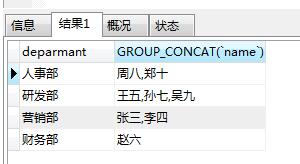
根据 department 分组,通过 group_concat('name'),查看每组里面的姓名都有哪些
SELECT gender,GROUP_CONCAT(`name`) from employee GROUP BY gender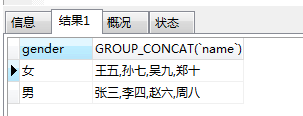
根据gender 分类,看 不同的 性别都有哪些 人
分组注意事项: 在分组时,select后面跟的的字段一般都会出现在 group by 后
SELECT name,gender from employee GROUP BY gender,name
-- 先按gender分组,再按姓名分组...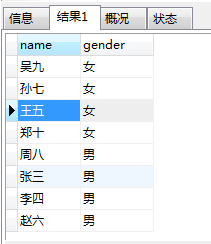
2.SQL分组+聚合函数
select deparmant, GROUP_CONCAT(salary), SUM(salary),AVG(salary) 平均工资,MAX(salary) 最高工资 from employee GROUP BY deparmant;
-- 根据department 分组,计算各部门下工资总数,平均工资,最高工资
-- 查询每个部门的部门名称以及每个部门的人数
SELECT deparmant, GROUP_CONCAT(`name`), COUNT(*) from employee GROUP BY deparmant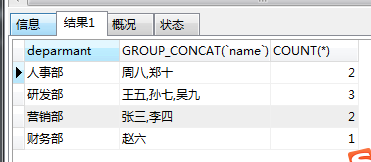
-- 查询每个部门的部门名称以及每个部门工资大于1500的人数
SELECT deparmant,GROUP_CONCAT(salary), COUNT(*) from employee WHERE salary > 1500 GROUP BY deparmant
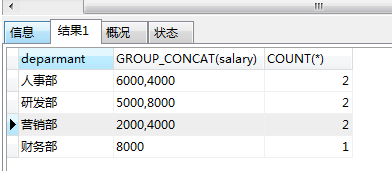
3.SQL分组GroupBy+Having
- group by + having 用来分组查询后指定一些条件来输出查询结果
- having 和 where 一样,但 having 只能用于 group by
-- 查询工资总和大于 9000的部门名称
SELECT deparmant, GROUP_CONCAT(salary), SUM(salary) FROM employee
GROUP BY deparmant
HAVING SUM(salary) > 9000;
having 和 where 的区别:
- having 是在分组后对数据进行过滤,where 是在分组前对数据进行过滤
- having后面可以使用分组函数(统计函数),where后面不可以使用分组函数
- where 是对分组前记录的条件,如果某行记录没有满足where字句的条件,那么这行记录不会参加分组;而having是对分组后数据的约束
-- 查询工资大于2000的,工资总和大于9000的部门名称以及工资和
select deparmant,GROUP_CONCAT(salary), SUM(salary) from employee
WHERE salary > 2000
GROUP BY deparmant
HAVING sum(salary) > 9000
ORDER BY SUM(salary) DESC;
4.sql语句书写顺序

转载自:https://www.cnblogs.com/friday69/p/9389720.html
作者:陈耿聪 —— 夕狱
出处:https://www.cnblogs.com/CGCong/
本文版权归作者和博客园共有,欢迎转载,但未经作者同意必须保留此段声明,且在文章页面明显位置给出原文连接,否则保留追究法律责任的权利。



